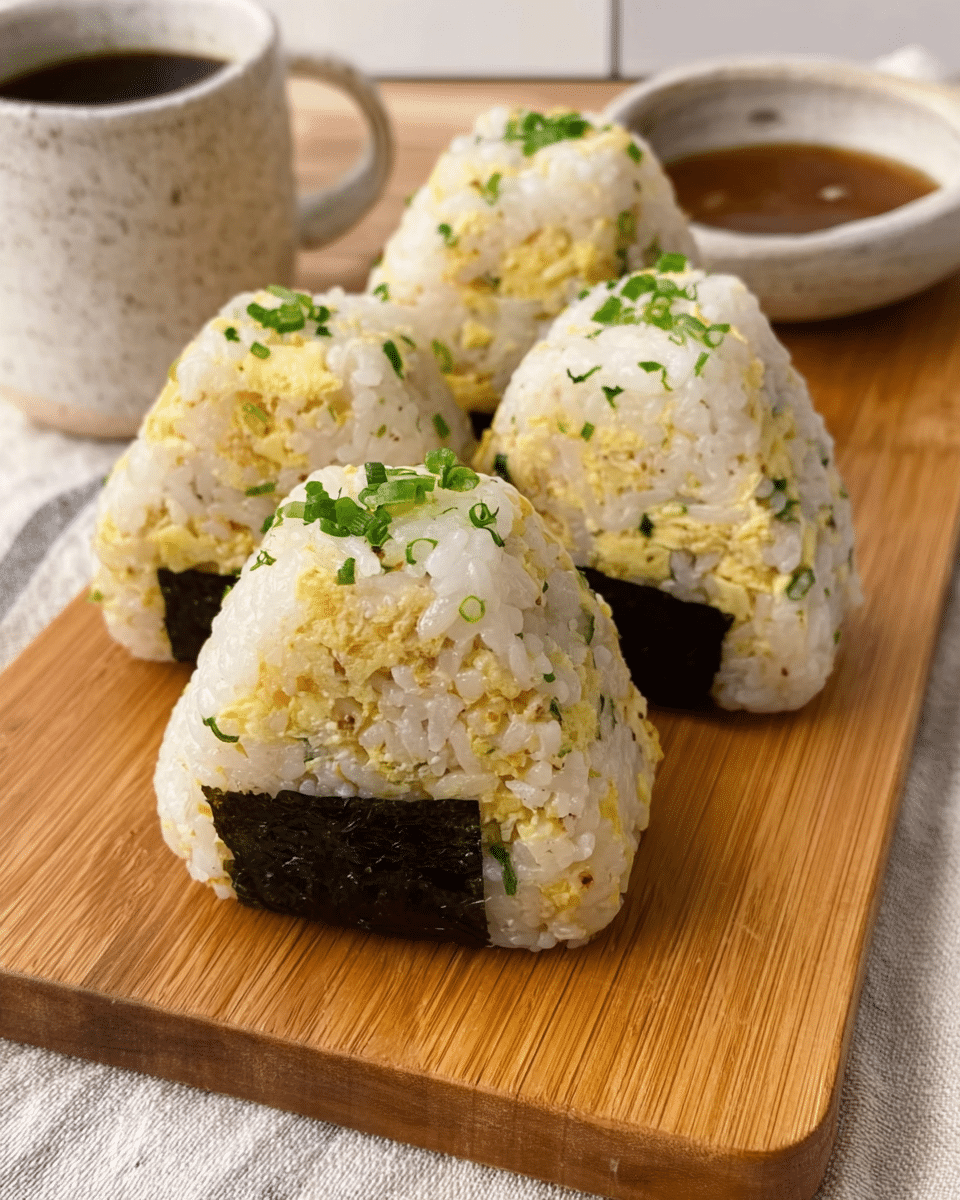Egg Onigiri is a simple and flavorful twist on traditional rice balls, making it a great snack, lunch, or picnic option. With just a few ingredients like eggs, chives, and rice, this easy recipe brings together creamy and savory flavors in a fun, triangle-shaped snack. You can even get creative by adding your favorite protein. Ideal for quick meals or when you’re craving a light and delicious treat.
Full Recipe:
Ingredients
-
2 eggs
-
10 g chives, finely chopped
-
1 ½ tbsp mayonnaise
-
1 sheet roasted seaweed
-
300 g cooked white rice
-
2 ½ tbsp soy sauce
-
1 tbsp sesame oil
Directions
-
Prepare the Eggs
Crack the eggs into a bowl, add a pinch of salt, and whisk them. Heat a pan over medium heat, add cooking oil, and pour in the egg mixture. Stir continuously to scramble the eggs, using a spatula to break them into small pieces. Set aside. -
Mix the Rice
In a large bowl, add the cooked rice, chopped chives, scrambled eggs, sesame oil, soy sauce, and mayonnaise. Mix everything together using your hands. -
Shape the Onigiri
Cut a few 5 cm x 8 cm pieces from the roasted seaweed. Using gloves, form the rice mixture into a ball, then flatten slightly and shape it into a triangle. -
Add Seaweed
Place a piece of roasted seaweed at the bottom of the onigiri triangle. -
Serve
Enjoy your delicious homemade egg onigiri as a snack, lunch, or a light dinner!
Nutrients
While exact nutritional values may vary, here’s an estimate for one serving (1 onigiri):
-
Calories: 320 kcal
-
Protein: 9 g
-
Carbohydrates: 40 g
-
Fiber: 1 g
-
Sugars: 3 g
-
-
Fat: 15 g
-
Saturated Fat: 2 g
-
-
Cholesterol: 130 mg
-
Sodium: 720 mg
-
Calcium: 30 mg
-
Iron: 2 mg
This estimate is based on typical portion sizes and may vary depending on specific ingredients used.
What is Onigiri?
Onigiri is a traditional Japanese food made from white rice, often shaped into triangular or cylindrical forms and wrapped in a sheet of roasted seaweed. It’s typically filled with savory ingredients like pickled plums, salted salmon, or other fillings. Onigiri is beloved for its convenience, portability, and ability to carry a variety of fillings, making it ideal for lunchboxes, picnics, or quick snacks. While traditional fillings like umeboshi (pickled plums) or grilled fish are common, this Egg Onigiri variation adds a comforting, creamy element that’s both easy to prepare and incredibly satisfying.
Egg Onigiri: A Creamy, Savory Twist
Eggs are a versatile ingredient that add both flavor and texture to many dishes, and in this recipe, they play a central role in creating a creamy filling for the rice. The scrambled eggs are soft and light, adding richness to the rice mixture. Paired with sesame oil, soy sauce, and mayonnaise, the eggs are seasoned perfectly, creating a savory depth of flavor that complements the mild rice.
The addition of finely chopped chives brings a touch of freshness and mild onion-like flavor, balancing the richness of the eggs. The roasted seaweed adds a final touch of umami and a crisp texture when wrapped around the onigiri. Together, these ingredients create a delightful balance of creamy, savory, and slightly sweet flavors, making the onigiri both comforting and satisfying.
Why This Recipe Works for Busy Days
One of the main attractions of Egg Onigiri is its quick preparation time. The entire recipe can be completed in under 30 minutes, making it an ideal choice for busy days when you want something hearty and flavorful without spending too much time in the kitchen. The ingredients are simple and easy to find, and it can be made using leftover rice, making it an excellent way to use up extra rice from previous meals.
The combination of eggs and rice provides a good balance of carbohydrates and protein, while the sesame oil and soy sauce add healthy fats and umami to the dish. This makes it a well-rounded and satisfying option that doesn’t require much effort, but still delivers delicious results.
Customizing Egg Onigiri with Your Favorite Protein
While this recipe focuses on eggs as the primary filling, you can easily customize your onigiri by adding different proteins to suit your tastes. For example, you could include cooked chicken, tuna, or shrimp for an added protein boost. You could also experiment with adding vegetables like sautéed spinach, mushrooms, or avocado for a more filling and nutrient-packed version.
For a spicier twist, a little sriracha or chili paste could be added to the rice mixture, or even a bit of grated cheese for a fusion twist. Onigiri is incredibly versatile, so you can use it as a base for all sorts of creative fillings, depending on what you have available or what you’re in the mood for.
The Benefits of Using Roasted Seaweed
Roasted seaweed, or nori, is a key ingredient in onigiri that adds a subtle umami flavor, making it an essential component for that authentic taste. Seaweed is rich in essential minerals like iodine and calcium, and it also provides dietary fiber, making it a nutritious addition to the dish. When used as a wrap around the onigiri, it adds a slight crunch and enhances the overall flavor with its distinctive taste. The seaweed’s saltiness pairs well with the savory rice and egg mixture, providing a satisfying contrast to the creamy, fluffy filling.
Serving Suggestions
Egg Onigiri is wonderfully versatile, whether served as a quick snack, a light lunch, or part of a larger meal. You can serve it as an appetizer for a Japanese-themed dinner or pair it with a side of soup or salad for a more complete meal. For a light dinner, consider serving it alongside a bowl of miso soup or a fresh cucumber salad. The onigiri also pairs nicely with green tea, which complements its savory flavor profile.
If you’re packing it for lunch or a picnic, Egg Onigiri makes for a convenient and portable option. It’s easy to eat on the go and can be enjoyed at room temperature, making it perfect for packed lunches, road trips, or outdoor gatherings.
Storage Tips
If you have leftover Egg Onigiri, store it in an airtight container to keep it fresh. You can also wrap each onigiri individually in plastic wrap to preserve its shape and prevent it from drying out. Onigiri can be stored in the refrigerator for up to 2-3 days, but it’s best enjoyed within a day or two to maintain its texture and flavor.
For longer storage, you can freeze the onigiri. Simply wrap each one tightly in plastic wrap and place them in a freezer-safe container. When ready to eat, simply thaw the onigiri in the refrigerator and enjoy it at room temperature, or briefly microwave it to soften the seaweed if you prefer it warm.
Nutritional Information
Egg Onigiri is a filling and nutrient-packed dish, offering a good balance of protein, healthy fats, and carbohydrates. At approximately 320 kcal per serving (one onigiri), it’s a satisfying snack or light meal. The dish contains a decent amount of protein (9 g) from the eggs and soy sauce, along with healthy fats from the sesame oil. The 8 g of carbohydrates make it a moderate energy source, and the fiber from the rice and seaweed helps with digestion. Additionally, the dish provides a modest amount of iron and calcium, thanks to the eggs and seaweed.
Conclusion
Egg Onigiri is a fun, flavorful twist on a classic Japanese snack that’s easy to make, customizable, and delicious. With just a few ingredients, you can create a satisfying dish that’s perfect for a quick meal, snack, or picnic. The creamy scrambled eggs, savory soy sauce, and crispy seaweed come together in a perfect bite, and you can experiment with different fillings to make it your own. Whether you’re looking for a simple snack or a light meal, Egg Onigiri is a versatile and tasty option that’s sure to please.






